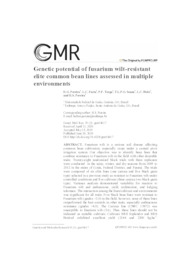Genetic potential of fusarium wilt-resistant elite common bean lines assessed in multiple environments.
Genetic potential of fusarium wilt-resistant elite common bean lines assessed in multiple environments.
Author(s): PEREIRA, D. G.; FARIA, L. C. de; TORGA, P. P.; SOUZA, T. L. P. O.; MELO, L. C.; PEREIRA, H. S.
Summary: Fusarium wilt is a serious soil disease affecting common bean cultivation, especially crops under a central pivot irrigation system. Our objective was to identify bean lines that combine resistance to Fusarium wilt in the field with other desirable traits. Twenty-eight randomized block trials with three replicates were conducted in the rainy, winter, and dry seasons from 2009 to 2012 in the states of Goiás, Federal District, and Paraná. The trials were composed of six elite lines (one carioca and five black grain type) selected in a previous study as resistant to Fusarium wilt under controlled conditions and five cultivars (three carioca two black grain type). Variance analysis demonstrated variability for reaction to Fusarium wilt and anthracnose, yield, architecture, and lodging tolerance. The interaction among the lines/cultivars and environments was significant for all traits. Five black bean lines were resistant to Fusarium wilt (grades <3.0) in the field; however, none of these lines outperformed the best controls in other traits, especially anthracnose resistance (grades >4.0). The Carioca line (CNFC 15872) was susceptible to fusarium wilt (5.6). Thus, these lines should not be indicated as suitable cultivars. Cultivars BRS Esplendor and BRS Notável exhibited excellent yield (2144 and 2200 kg.ha-1, respectively), high stability, erect architecture (3.4 and 4.1), lodging tolerance (3.3 and 4.0), anthracnose resistance (1.0 and 1.7), and high fusarium wilt resistance (2.0 and 2.6). These cultivars are still excellent options for planting in areas with Fusarium wilt.
Publication year: 2020
Types of publication: Journal article
Unit: Embrapa Rice & Beans
Observation
Some of Embrapa's publications are published as ePub files. To read them, use or download one of the following free software options to your computer or mobile device. Android: Google Play Books; IOS: iBooks; Windows and Linux: Calibre.
Access other publications
Access the Agricultural Research Database (BDPA) to consult Embrapa's full library collection and records.
Visit Embrapa Bookstore to purchase books and other publications sold by Embrapa.

